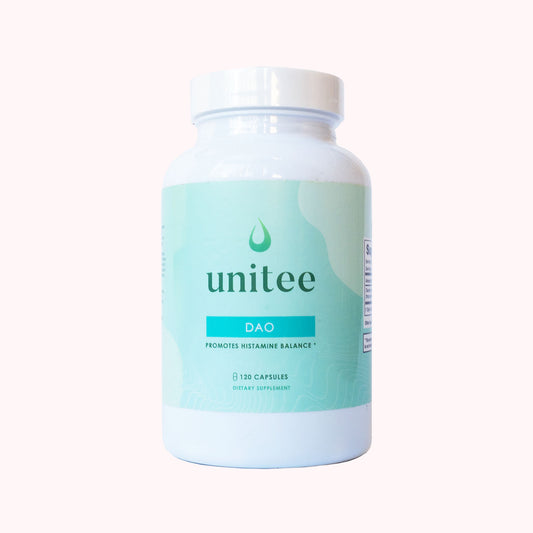Your genes dictate who you are, and this is true for what happens both from a physical and a biological perspective!
Think about your eye and hair color. You weren’t randomly assigned to be born with green eyes and blonde hair. Your carefully constructed genetic code allocated those specific traits to you, long before you were even conceived.
In terms of biological genes, they are also responsible for your body shape, your likes and dislikes, your personality, and a whole lot of other things about you that make you, you. These traits have been passed down from generation to generation, and you can see this just by looking at your relatives who will all share some similar features.
It's not only about what you look like or how you act, genes are also in control of many aspects of your health. Our genes can provide us with either protective aspects against certain diseases and conditions, or they can leave us more at risk.
You see, it all has to do with genetic mutations, which we'll get into in a little bit. And while mutations may sound like a scary word, it's not always bad news, especially when those mutations help us to clear toxins more easily, or they allow us to build stronger muscles and bones, for example.
Yes, some mutations are not as helpful, which is what we're going to get into today.
When it comes to histamine intolerance (HIT), there are a number of genes that have been found to increase the risk of developing this condition.
Common Genes That Increase the Risk of Histamine Intolerance: DAO, HNMT, MTHFR, MAO and HDC
Without getting into too much of the science behind genes, there’s a little bit about them you need to know to understand why a genetic factor can be the cause of your symptoms of HIT.
Each gene is made up of a number of different codes. These codes tell the body to make specific proteins.
Proteins are what make the entire body function, where these little compounds tell each cell what it needs to do. Basically, each protein has a specific receptor to which it attaches on a cell. When the protein attaches to its receptor, the cell carries out a function. Depending on the type of code that the gene uses to create a protein, that function carried out can vary depending on the individual.
Mutations are typically what causes the function of the protein to vary.
Some genes have been put together with the wrong code, where it’s possible that a ‘typo’ crept in when your DNA was being made or you inherited the typo from one of your parents. It's these typos that are known as mutations, or single nucleotide polymorphisms (SNiPs).
Depending on how much of the code is wrong, the capacity of the protein to tell the cell what to do is changed, and so the cell may simply not work at 100% of what it is truly designed to do. In most cases, it affects enzymatic processes of the cell to change, and decreases the capacity of those enzymes to be made, which is where histamine intolerance comes in. If the enzymes that degrade histamine aren't being made in the quantities needed to control histamine levels, these levels will rise and result in symptoms.
There are five common genetic changes that can increase your risk of histamine intolerance.
1. DAO - AOC1
Diamine oxidase (DAO) is an enzyme that the body uses to break down histamine. When there is too little of this enzyme produced, histamine levels within your system increase.
DAO is one of the most important enzyme the body needs to be able to break histamine down, particularly when it comes to the histamine that is produced in the gut. Because there is a chance of high histamine influx into the digestive system, both from food and that which is produced by gut bacteria, DAO production really needs to be on point. When it’s not, and the gene that codes for its production is not working effectively, symptoms of histamine intolerance can arise (1,2).
When there's a problem with the ability to make the DAO enzyme, and it's a DAO deficiency that reduces the body's ability to metabolize and break down histamine leading to the symptoms of histamine intolerance, it’s referred to as a primary DAO insufficiency. And it's usually a problem with the genetic ability to make DAO, as I've mentioned above.
Fortunately, even though you can't change your genes and their ability to make more DAO, DAO supplements are available. They work very well when it comes to helping to break down histamine in the gut and, therefore, can be an effective way to both prevent and relieve symptoms.
2. HNMT - C939T
Another enzyme the body uses to break down histamine located within the cells of the body, and which is released elsewhere, is called histamine N-methyltransferase (HNMT). It is particularly active in the central nervous system, which is made up of the brain and the spinal cord (3). When there is insufficient HNMT made due to a genetic predisposition, there may be an increase in the symptoms of histamine intolerance associated with activation of the receptors in the brain. These symptoms can include heightened anxiety, mood swings, and even Parkinson’s Disease (4,5,6). It's these symptoms that are often chalked up to being related to mood disorders, or brain disorders. Instead, the underlying cause may be a histamine overload, acting as a chemical messenger without an off-switch, which then disrupts the functions of the nervous system, resulting in these symptoms.
3. MAO - MAO
Monoamine oxidase (MAO) is yet another enzyme that helps to degrade biogenic amines. While it’s not the primary function of MAO to degrade histamine, too little of this enzyme can still impact histamine levels due to the build up of these other biogenic amines and how they influence the release of histamine. It's noteworthy to mention that the symptoms associated with and MAO deficiency may be even more severe than those suggesting histamine intolerance. When there is a change in the gene that dictates the production of MAO, levels of the other more dangerous biogenic amines such as tyramine and catecholamines rise, too (7). They both have a stimulatory effect on the cardiovascular system, increasing blood pressure and heart rate, which may increase the risk of cardiovascular events.
4. MTHFR - A1298
It is believed that around 50% of people have the MTHFR genetic mutation. This enzyme, called methylenetetrahydrofolate reductase (MTHFR), is an important compound involved in the folic acid cycle. It’s a critical step in converting folic acid into another essential compound that are needed for a process called methylation.
Methylation is one of the pathways the body uses for detoxification, energy production, DNA repair and inflammatory responses, and it also helps to reduce the body’s histamine levels. Methylation status can seriously impact histamine levels, where a gene mutation that disrupts the methylation pathways can decrease the body's ability to methylate correctly, which can cause and increase in the number of mast cells to be produced in various organs and tissues. When there are more mast cells, there's a greater chance of them being activated, which causes them to release more histamine into the body (8,9,10).
There is a way to skirt around this genetic mutation and its impact on methylation. Taking a methylated folic acid supplement for example (11), or increasing your choline intake (12,13), can help to improve how the methylation cycle is able to function and, in doing so, support the processes
needed for histamine balance.
5. Histidine decarboxylase - HDC
Histidine decarboxylase (HDC) dictates how easily the body can make histamine from the ingested amino acid histidine. When there is a mutation in this gene, histamine levels may rise. Research shows that those who have changes in this gene are more prone to developing allergies and a runny nose as a result (14,15,16).
If you'd like a more in depth view into how specific histamine clearing genetic mutations may increase your risk of histamine intolerance, read my article about it, here...
Histamine Intolerance and Genetics: The Bottom Line
What is important to realize is that, while you may be a carrier of some of these genes, they don’t always mean for certainty that a condition will develop.
The ‘activation’ of a specific gene can cause symptoms to develop, however, should these factors that influence the gene be managed, and the triggers of that gene be moderated, the condition may be well managed (17).
This concept is certainly applicable to histamine intolerance.
Even if you have a reduced capacity to produce DAO because of a genetic predisposition, for example, decreasing your intake of foods that further inhibit DAO production may help to improve symptoms of HIT.
Supporting the body and its genetic processes can be the reason you are able to fully manage your condition with few, or no symptoms related to it.
For this reason, a histamine reduced diet is one of the best ways to quickly decrease the symptoms of histamine intolerance as it significantly reduces the load that histamine may be having on your body. For a detailed list of foods to eat and avoid, as well as more information on relieving histamine intolerance symptoms, click below to get my free eBook which is the ultimate guide to histamine intolerance!
- Petersen J, Raithel M, Schwelberger HG. Characterisation of functional polymorphisms of the human diamine oxidase gene. Inflamm Res 2005;54(suppl):S58–9.
- Maintz, L. et al. (2011). Association of single nucleotide polymorphisms in the diamine oxidase gene with diamine oxidase serum activities. Allergy, 66(7), 893-902.
- Schwartz, J , et al. Histaminergic transmission in the mammalian brain. 1991. Physiol. Rev. , 71, 1–51.
- Heidari, A., et al. Mutations in the histamine N-methyltransferase gene, HNMT, are associated with nonsyndromic autosomal recessive intellectual disability. 2015. Human Molecular Genetics. 24(20):5697-5710.
- Jiménez-Jiménez, F., et al. Thr105Ile (rs11558538) polymorphism in the histamine N-methyltransferase (HNMT) gene and risk for Parkinson disease. A PRISMA-compliant systematic review and meta-analysis. Medicine (Baltimore). 2016 Jul; 95(27): e4147.
- Agúndez, J., et al. Nonsynonymous polymorphisms of histamine-metabolising enzymes in patients with Parkinson's disease. Neuromolecular Med. 2008;10(1):10-6. Epub 2007 Nov 6.
- Maršavelski, A., & Vianello, R. What a Difference a Methyl Group Makes: The Selectivity of Monoamine Oxidase B Towards Histamine and N‐Methylhistamine. 2017. Chemistry: A European Journal. 23(12).
- Monticelli S, Leoni C. Epigenetic and transcriptional control of mast cell responses. F1000Res. 2017;6:2064. Published 2017 Nov 29. doi:10.12688/f1000research.12384.1
- Haenisch, B., Nöthen, M. M., & Molderings, G. J. (2012). Systemic mast cell activation disease: the role of molecular genetic alterations in pathogenesis, heritability and diagnostics. Immunology, 137(3), 197–205.
- Fryar-Williams, S. Fundamental Role of Methylenetetrahydrofolate Reductase 677 C → T Genotype and Flavin Compounds in Biochemical Phenotypes for Schizophrenia and Schizoaffective Psychosis. 2016. Front. Psychiatry.
- Chmurzynska, A., et al. Associations between folate and choline intake, homocysteine metabolism, and genetic polymorphism of MTHFR, BHMT and PEMT in healthy pregnant Polish women. Nutrition & Dietetics. 2019.
- Chew, T., et al. Folate Intake, Mthfr Genotype, and Sex Modulate Choline Metabolism in Mice. 2011. The Journal of Nutrition. 141(8): 1475-1481.
- Shin, W., et al. Choline Intake Exceeding Current Dietary Recommendations Preserves Markers of Cellular Methylation in a Genetic Subgroup of Folate-Compromised Men. J Nutr. 2010 May; 140(5): 975–980. https://www.ncbi.nlm.nih.gov/pmc/articles/PMC2855263/
- Hrubisko M, Danis R, Huorka M, Wawruch M. Histamine Intolerance-The More We Know the Less We Know. A Review. Nutrients. 2021;13(7):2228. Published 2021 Jun 29. doi:10.3390/nu13072228
- Garcia-Martin, E., et al., Histamine pharmacogenomics. Pharmacogenomics, 2009. 10(5): 867-83.
- Gervasini, G., et al., Variability of the L-Histidine decarboxylase gene in allergic rhinitis. 2010. Allergy. 65(12): p. 1576-84.
- Comas-Basté O, Sánchez-Pérez S, Veciana-Nogués MT, Latorre-Moratalla M, Vidal-Carou MDC. Histamine Intolerance: The Current State of the Art. Biomolecules. 2020;10(8):1181. Published 2020 Aug 14. doi:10.3390/biom10081181

Anita Tee
My name is Anita Tee. I'm a nutritional scientist who specializes in histamine intolerance. I hold a Master of Science in Personalized Nutrition and a Bachelor of Science in Human Biology and Psychology.
For the past ten years, I have used my experience in nutritional and medical health sciences to create a scientifically backed, natural approach to healthcare that relies 100% on evidence-based research.
As I previously suffered from - and overcame - histamine intolerance, my focus is to increase recognition and expand the available resources and protocols available for resolving this particular disorder. To date, I have helped over 4,000 individuals fully resolve or better manage their histamine intolerance symptoms.







